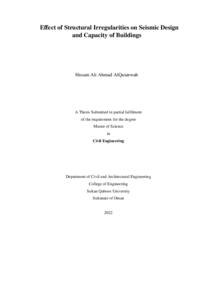Document
Effect of structural irregularities on seismic design and capacity of buildings.
Other titles
تأثير عدم الانتظام الانشائي على التصميم الزلزالي وقدرة المباني
Publisher
Sultan Qaboos University.
Gregorian
2022
Language
English
English abstract
In an earthquake the sudden release of energy due to the breaking and movement of the
tectonic plate leads to ground shaking. The behavior and performance of buildings during an
earthquake depends primarily on its' structural configuration. Nowadays, most buildings have
irregularities both in-plan and in-elevation due to architectural needs and service
requirements, which develops weak points in the structural system. Factors that influence the
structure's seismic behavior include structural configuration, architectural layout, structure
zonation and soil type. This study addresses the structural design and performance of buildings
under seismic loads considering various types and magnitude of irregularities in-plan and in elevations as defined by the Oman Seismic Code. A ten-story high regular reinforced concrete
building with a total height of 30 m, 20 m x 16 m plan dimension, 5 bays in the x-direction
and 4 bays in the y-direction, located in muscat, Zone-1, and soil class-C. for irregularities in plan, six cases with torsional irregularity, three cases of floor discontinuity, and four cases of
projection in-plan are used. Three cases of each weak story and soft story are considered for
in-elevation irregularities. The study, therefore, discussed 19 different structural
configurations in addition to the reference layout. All the cases are analyzed and designed
under the seismic loads with the same conditions for gravity loads using ETABS. The building
capacity and performance is estimated using pushover analysis, plastic hinges deformation,
and capacity-demand curve. It is noticed that the seismic irregularities in the structure have a
significant effect on structural performance, particularly the base shear, performance point,
and plastic hinges formation compared to the regular structure. The torsional behavior for the
structure was severe when a single shear wall is positioned at the periphery of the building
with a 1.85 irregularity factor, compared to the other shear walls configurations and locations.
For floor discontinuity, it is found that the centralized location of the floor opening is affecting
the structural behavior generating a more vulnerable structure due to the reduction of base
shear by 74% in the x-direction and 68% in the y-direction.
The opening located in the center caused higher base shear over the opening at the periphery.
With projection in plan, the performance of the building under seismic load will be affected
due to the stress concentration in the projection direction. For irregularities in-elevation, soft
story irregular models illustrate that increasing the first story height decreases the base shear
value due to the stiffness difference between the first story and the storys above. Due to the
non-continuity of vertical structural members at the first story, the structure's performance is
affected by the reduction of building capacity goes into the collapse prevention stage.
Irregularities will lead to a reduction in strength and stiffness in comparison to regular
structures.
Member of
Resource URL
Arabic abstract
أثناء الزلزال ، يؤدي الاطلاق المفاجئ للطاقة بسبب كسر وحركة الصفيحة التكتونية إلى اهتزاز الأرض. سلوك وأداء المباني خالل الزلازل يعتمد في المقام الأول على التكوين الهيكلي. في الوقت الحاضر ، تحتوي معظم المباني على عدم انتظام في المخطط والأرتفاع بسبب الأحتياجات المعمارية ومتطلبات الخدمة ، مما يؤدي إلى تواجد نقاط ضعف في النظام الهيكلي. تشمل العوامل التي تؤثر على السلوك الزلزالي للهيكل التكوين الهيكلي, التخطيط المعماري , تقسيم الهيكل ونوع التربة. تتناول هذه الدراسة التصميم الهيكلي وأداء المباني تحت الأحمال الزلزالية مع الأخذ في الأعتبار مختلف أنواع ودرجات عدم انتظام في المخطط والأرتفاعات على النحو المحدد في قانون الزالزل العماني. مبنى خرساني مسلح منتظم مكون من عشرة طوابق بارتفاع إجمالي 30 م ، وابعاد المخطط 20 م طول و 16 م عرض، و 5 مقاطع في الأتجاه الأفقي و 4 مقاطع في الأتجاه الرأسي ، ويقع في مدينة مسقط, المنطقة 1 ، وفئة التربة-ج. بالنسبة لعدم الأنتظام في المخطط ، يتم استخدام ست حالأت مع عدم انتظام الألتواء ، وثالث حالات انقطاع الأرضية ، وأربع حالات بروز في المخطط. بالنسبة لعدم الأنتظام في الأرتفاع ، يتم النظر في ثالث حالأت لالدوار الضعيفة و الأدوار الناعمة لكل منها. لذلك ، ناقشت الدراسة 19 مخطط هيكلي مختلف بالأضافة إلى المخطط المرجعي. يتم تحليل جميع الحالأت وتصميمها باستخدام برمجية إيتابس تحت الأحمال الزلزالية مع نفس الظروف ألحمال الجاذبية. يتم تقدير قدرة البناء والأداء باستخدام تحليل الضغط ، وتشوه المفاصل البالستيكية ، ومنحنى القدرة - السعة. يالحظ أن المخالفات الزلزالية في الهيكل لها تأثير كبير على الأداء الهيكلي ، وخاصة القص الأساسي ، ونقطة الأداء للمبنى ، وتشكيل المفاصل البلاستيكية مقارنة بالهيكل العادي المنتظم. سيكون السلوك الألتوائي للهيكل شديدا عندما يتم وضع جدار قص واحد في محيط المبنى مع عامل عدم انتظام بمقدار 1.85 مقارنة بتكوينات ومواقع جدران القص الأخرى. بالنسبة النقطاع الأرضية ، وجد أن الموقع المركزي النقطاع الأرضية يؤثر على السلوك الهيكلي الذي يولد بنية أكثر ضعفا بسبب تقليل القص الأساسي بنسبة 74 ٪ في الأتجاه الأفقي و 68 ٪ في الأتجاه الراسي. الفتحة الموجودة في المركز تسبب قص قاعدة أعلى مقارنة بالفتحة الموجودة في محيط المبنى. مع البروز في المخطط ، سيتأثر أداء المبنى تحت الحمل الزلزالي بسبب تركيز الأجهاد في اتجاه الأسقاط. بالنسبة لعدم الأنتظام في الارتفاع ، توضح النماذج غير المنتظمة للأدوار الناعمة أن زيادة ارتفاع الطابق الأولى تقلل من قيمة القص الأساسية بسبب اختلاف الصلابة بين الطابق الأولى والطوابق أعلاه. بسبب عدم استمرارية أعضاء الهيكل العامودية في الطابق الأول ، يتأثر أداء الهيكل من خلال الحد من قدرة المبنى يؤدي إلى مرحلة منع الأنهيار.سيؤدي عدم الأنتظام الأنشائي إلى انخفاض القوة والصلابة مقارنة بالمباني المنتظمة.
Category
Theses and Dissertations

